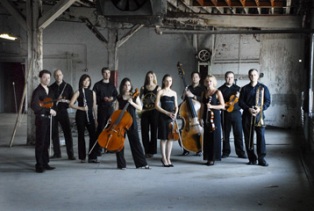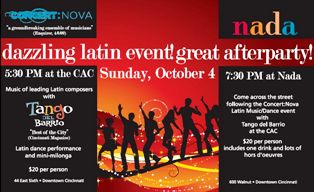concert:nova Keeps the Latin Rolling
Mary Ellyn Hutton
Posted: Oct 5, 2009 - 12:45:01 AM in
reviews
 musicians of concert:nova |
concert:nova tangoed into the night at the Contemporary Arts Center Sunday (Oct. 4), carrying on the Latin beat struck by the Cincinnati Symphony Orchestra Friday and Saturday at Music Hall.
There was a bandeonist, American-born Ben Bogart from Buenos Aires, also soprano Ellen Wieser, pianist Audrey Causilla and guitarist Richard Goering.
concert:nova musicians included violinists Mauricio Aguiar and Tatiana Berman, violist Heidi Yenney, cellist Theodore Nelson, bassist Owen Lee, flutist Randolph Bowman and clarinetist Ixi Chen.
Providing the something extra that is part of all c:n concerts were dancers from Tango del Barrio, Chuck Reder, Debby Vigna, Julie Barnett, Nuria Lopez-Ortega, Jake Moscovitch, Ella Moscovitch and Tony Seta.
(Tango del Barrio is a local Argentine social club that offers classes in Argentine tango and sponsors regular tango dances. Visit them at
www.TangoDelBarrio.com)
Program-wise, it was like tapas buffet, with 15 selections, from Manuel de Falla to Ljova, ranging from Argentina, Uruguay, Brazil and Spain.
CSO principal oboist and c:n member Dwight Parry, rose in his lapel, emceed the event and provided engaging commentary (hear him play on other c:n concerts this season).
First on the menu was actually a bagel, i.e. "Bagel on the Malecon" by New Yorker Lev Zhurbin, also known as Ljova, who tapped Cuban son to conjure eating a bagel on Havana's boardwalk. Originally for "vjolas" (violist Zhurbin's spelling of violas), it was performed spiritedly by Aguiar, Yenney and Nelson.
Violinist Berman, smartly attired in a mottled red dress with spike-heeled red shoes, joined them in the Allegro violento e agitato (Parry: "very angry") of Ginastera's 1948 String Quartet No. 1. Aguiar drew a gutsy sound from his violin, playing high on its lowest string (G) against a steady rhythm by the other members of the quartet. Canadian-born Wieser wore a red rose in her hair and displayed a lovely lyric voice in two of the "Cuatro Madrigales Amatorios" ("Four Love Songs") by Joaquin Rodrigo. They were a contrasting pair. The first, "Vos me matasteis" (You've killed me") was about painful love. The second was a complaint, "De donde venis, amore?" ("Where have you been, love?") sung with foot-tapping, arms-crossed consternation.
Goering and Nelson introduced both a composer and his work with the first two movements from the Sonata for Guitar and Cello by Brazilian Radames Gnatalli (1906-88). Composed in 1969, it was one of the finds on the program, colorful and melodic, with irregular rhythms and the cello sometimes strummed like a second guitar.
Ginastera's "Impresiones de la Puna" refers to the land of the Incas, said Parry and it, too, was very rewarding. Scored for flute (Bowman) and string quartet (Berman, Aguiar, Yenney and Nelson), it has three movements. The mysterious "Quena" began with the flute in its dark, lowest register. "Cancion" contrasted lush, sweetly melodic sections with more agitated ones. Randolph shone brightly in the alternately animated and relaxed "Danza."
Soprano Wieser and a string quintet, including Lee on double bass performed the Aria (Cantilena) from Villa Lobos' "Bachianas Brasilieras" No. 5. Scored lavishly for eight cellos in the original, it nevertheless sounded full and rich, with violist Yenney offering a soulful melody at one point. Wieser sang with great tonal beauty, and her hummed reprise cast a bewitching spell.
Following intermission came the lighter half of the program, including eight tango selections. Four of them were accompanied by Tango del Barrio's skilled dancers.
It opened, however, with four of Falla's "Siete canciones populares espanoles" (Seven Popular Spanish Songs) performed by Bowman and Causilla. These are exquisitely evocative works. You could almost feel the teardrops falling in "Asturiana" about a pine tree that "weeps to see me weeping." "Jota" anticipates the jota from Falla's later "Three-Cornered Hat," while "Nana" was a gentle, Spanish-inflected lullaby. The "pain in the heart" in "Polo" was manifest by pounding piano and strident flute, capped by Bowman's final, high-pitched exclamation.
Another highlight was "Nightclub 1960" for violin and guitar. It is the third installment in Piazzolla's "Histoire du Tango," a set of four movements outlining the evolution of the tango, from its seamy origins in turn-of-the-century Buenos Aires bordellos to its present state as exalted by classical composers (like Piazzolla). Rose in the scroll of her violin, Berman gave it a richly colored, beautifully shaped rendition -- from brightly focused to feathery to sassy -- kindled by expressive vibrato and piquant effects like scratching behind the bridge with her bow.
There was more Piazzolla, including "Escualo," for violin, bandoneon, double bass and piano, where bandoneonista Bogart used the instrument both percussively and as a melodic double for the violin. The heat of the tango dissipated in a downward fizzle by Aguiar at the end.
The dancers took the floor in Eduardo Arolas' "Comme il faut," an upbeat tango, followed by Piazzolla's mournful "Oblivion" for instruments alone.
Jerzy Peterburshsky's dramatic "El sol sueno," where even the double bass gets the melody, featured Aguiar, clarinetist Chen, Nelson, Bogart, Lee and Causilla. Uruguayan Rosita Melo's "Desde el Alma" ("From the Soul") was a cheerful waltz tango, with violins in thirds and dancers again sweeping the floor in front of the stage. It was fun to see the women improvise kicks and leg wraps in response to the men's lead (in tango the man always leads) and each couple executing different patterns.
(Yenney, who wore a very cool pair of black tango shoes with red straps, looked as if she should have taken a turn with them.)
Piazzolla's "Milonga del Angel" for violin (Aguiar), guitar, bandoneon, double bass and piano, had a jazz flavor tinged with blues, and the dancers returned for the finale, Manuel Carretero's "Ella es asi" ("She's like that") where all ten musicians gave the concert a bright, energetic finish.
The concert was followed by an after-party at Nada restaurant across the street on Walnut.
The next concert:nova performance will be in December (date to be announced) at the c:n garden, 538 Reading Rd. The program, "Playing with Light" will feature video artist Charles Woodman and visual artist Tony Luensman, who will provide visual commentary on music by George Crumb, Arvo Pärt, Andre Jolivet and Toru Takemitsu.
In February there will be a "Mahler Project" in celebration of the composer's 150th anniversary, with chamber ensemble versions of his "Das Lied von der Erde" and Fourth Symphony.
April will bring "Four Seasons" by Vivaldi, Piazzolla and American composer Aaron Jay Kernis' "Culinary Four Seasons."
In May, c:n will welcome choreographer Heather Britt, dancers from Cincinnati Ballet and a team of local composers led by Joel Hoffman, who will "interpret" Saint-Saens'"Carnival of the Animals."
The c:n season concludes in June with "Mirror in the Mirror," a celebration of fugue and counterpoint, with a presentation of video artist Trinidad MacAuliffe's visual interplay of live and pre-recorded c:n musicians.
All dates will be announced.




